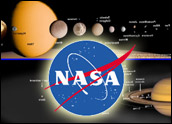
Last November, a European probe took off on a 250-million mile trip to visit Earth’s nearest neighbor, Venus. The European Space Agency (ESA) Venus Express team is now standing by as it waits for the probe to touch down tomorrow.
The mission’s first, and most important, objective is the Venus Orbit Insertion (VOI) maneuver. This task involves a series of telecommands, engine burns and other movements to slow the 2,799-pound spacecraft so it can enter orbit around Earth’s sister planet. The process will take about an hour.
The team commanding the spacecraft is based at ESA’s European Spacecraft Operations Center (ESOC) in Darmstadt, Germany.
Fast Trip
During the Venus Express Mission, a specially designed scientific satellite will study the planet’s atmosphere from the surface of Venus all the way to space — measuring interactions with the solar wind, for example, according to Don McCoy, Venus Express project manager.
The US$260 million project is so named because the probe’s journey from conception to arrival at Venus took place in less than four years — an ESA record — the space agency said.
Scientists hope to determine the cause of the planet’s shrouded atmosphere and how it maintains high temperatures of 470 degrees with a pressure 90 times more dense than on Earth. The pressure is comparable to that experienced 3,280 feet under the ocean, or 10 football fields deep.
The planet’s atmosphere consists mainly of carbon dioxide, but it has 30 miles of a sulfuric acid cloud layer and other elements that aren’t understood. As a result of the thick atmospheric blanket, Venus experiences a large-scale greenhouse effect leading to its temperatures that are hot enough to melt lead. Scientists hope to find an explanation as to what caused the greenhouse conditions to develop on Venus.
What Went Wrong?
Earth and Venus are similar in size, chemical compositions and densities. Yet, they’re very different. For one, Venus rotates in the opposite direction and at a much slower pace, with one Venus day equaling 243 Earth days. The analogy of a birthday in hell every other day has earned the planet its “Evil Twin” nickname.
“We hope to identify these mysterious compounds — compare Venus to Earth and Mars to see how Venus went so badly wrong,” said Larry Esposito, Ph.D., professor at University of Colorado at Boulder and a member of the Venus Express camera science team focusing on the mysterious blue absorbers in the Venus clouds. The team expects photos to begin arriving on Friday.
“Venus has become somewhat of a ‘forgotten planet’ with the emphasis on Mars exploration in the U.S.,” Esposito told TechNewsWorld. “But Venus can tell us about Earth’s future and about planets around other stars — I expect we will discover a number of surprises from this most capable new mission.”
Barring no issues, the spacecraft will enter orbit around the planet’s poles in its first nine days. The probe contains seven instruments that are spare parts from past missions, including ESA’s Mars Express and Rosetta comet chaser programs, which allowed the agency to build the probe quickly and cheaply.
Mars data is currently coming in, and the use of the same instruments at the same time should make it easier to compare Mars and Venus.
The main exploration phase of the Venus mission will begin in June. Though planned to extend for two Venus days — 486 Earth days — the mission might last twice as long if all goes well, said McCoy.




















































